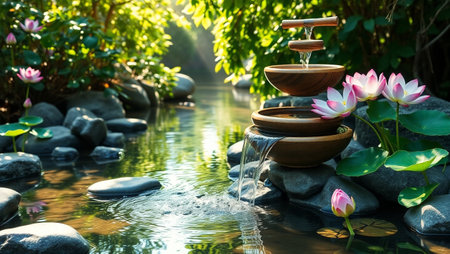Introduction to Sustainable Ornamental Water Features
In the UK, gardens have long served as sanctuaries of beauty and relaxation, with ornamental water features playing a central role in many landscapes. From tranquil ponds to elegant fountains, these elements offer soothing sights and sounds that enhance outdoor spaces. However, as environmental awareness grows and water conservation becomes increasingly vital, British homeowners and garden designers are rethinking traditional approaches. The challenge now is to harmonise the timeless appeal of water features with modern demands for sustainability and efficiency. This article explores how integrating thoughtfully designed water features can maintain garden aesthetics while addressing pressing environmental concerns and supporting responsible water use across the country.
Traditional British Water Feature Styles
Britain’s gardens have a rich tradition of ornamental water features that blend elegance with timeless appeal. Classic elements such as ponds, fountains, and rills are not just decorative—they also reflect centuries of horticultural heritage and national identity. Understanding these traditional styles is essential when seeking to balance beauty with modern-day efficiency, especially in today’s context of mindful water usage.
Ponds: Reflecting Tranquillity and Wildlife
Garden ponds have been a staple in British landscapes since the Tudor period. They were originally designed both for aesthetic pleasure and to support local wildlife. Traditional ponds often showcase native aquatic plants, stone edging, and gentle slopes that encourage biodiversity. Their reflective surfaces add serenity to any outdoor space, while their historic role in country estates brings a sense of continuity and charm.
Fountains: Grandeur and Movement
Fountains became popular during the Georgian and Victorian eras, symbolising wealth and sophistication. Whether grand tiered centrepieces or subtle wall-mounted designs, they use movement and sound to create sensory interest. British fountains often feature classical motifs, urns, or sculptural details inspired by European art, blending formality with artistic flair.
Rills: Subtle Flow and Structure
Rills are narrow channels that guide water through the garden, originating from Moorish influences but firmly embedded in British landscape design since the Arts & Crafts movement. Rills offer understated elegance; their gentle flow adds soft sound without excessive splashing. They can link different garden areas while using minimal water compared to larger installations.
Overview of Traditional British Water Features
| Feature Type | Key Characteristics | Cultural Significance | Water Usage Consideration |
|---|---|---|---|
| Pond | Still water, supports wildlife, naturalistic shapes | Historic estate gardens, ecological value | Can be designed for rainwater collection |
| Fountain | Moving water, sculptural elements, visual focal point | Status symbol, sensory enhancement | Recirculating pumps reduce waste |
| Rill | Narrow channel, slow-moving water, geometric layout | Arts & Crafts gardens, subtle sophistication | Low evaporation due to covered or shaded design |
The Balance of Tradition and Efficiency
While these traditional features embody British charm and history, adapting them for lower water consumption allows you to enjoy their beauty responsibly. Thoughtful design choices—such as utilising recirculation systems or integrating native planting—ensure that classic British water features remain sustainable for future generations.
![]()
3. Modern Solutions for Water Efficiency
In the quest to harmonise ornamental beauty with water conservation, modern technology offers several practical solutions perfectly suited to the UK’s unique climate. One of the most effective innovations is the use of recirculating systems. These systems ensure that water in features such as fountains and small ponds is continually reused, significantly reducing overall consumption and minimising waste. Particularly important in regions where rainfall can be unpredictable, these closed-loop setups are both eco-friendly and cost-efficient.
Solar Pumps: Sustainable Power Sources
Solar pumps have emerged as a popular choice for powering garden water features across the UK. By harnessing renewable energy from the often elusive British sun, these pumps maintain water movement without relying on mains electricity. This not only cuts down on energy costs but also supports the broader push towards sustainability. For smaller installations or shaded gardens, solar battery storage options ensure reliable operation even on cloudy days.
Water-Saving Materials and Design
Selecting water-saving materials is another key strategy. Features crafted from impermeable liners and sealed stonework help prevent seepage, ensuring that every drop stays within the system. Additionally, using gravel beds or drought-resistant aquatic plants can minimise evaporation and further reduce water requirements. Thoughtful design choices—such as shallow basins or tiered cascades—can create visual interest while keeping water volumes low, making them ideal for British gardens where space and resources may be limited.
Tailoring Technology to Local Needs
Ultimately, integrating these modern methods allows homeowners to enjoy stunning ornamental water features without compromising on efficiency. By choosing recirculating systems, solar-powered pumps, and smart materials tailored to the British climate, it’s entirely possible to achieve a garden that balances aesthetic appeal with responsible resource management.
4. Selecting Plants and Materials with Purpose
Creating an ornamental water feature that is both beautiful and efficient begins with thoughtful selection of plants and materials. By choosing native UK aquatic plants and hardscape elements suited to local conditions, you can enhance your garden’s aesthetic while reducing water consumption and maintenance needs.
Choosing Native Aquatic Plants
Native aquatic plants are naturally adapted to the UK climate, requiring less supplemental water and care compared to exotic species. They also support local biodiversity and can help maintain a balanced ecosystem within your water feature.
| Plant Name | Type | Visual Appeal | Water Demand |
|---|---|---|---|
| Yellow Flag Iris (Iris pseudacorus) | Marginal Plant | Striking yellow flowers in spring/summer | Low once established |
| Water Forget-Me-Not (Myosotis scorpioides) | Bog/Marginal Plant | Delicate blue blooms, long flowering season | Moderate, prefers moist soils |
| Brooklime (Veronica beccabunga) | Mature Aquatic Plant | Lush green foliage, tiny blue flowers | Low to moderate, tolerates partial drying out |
| Water Mint (Mentha aquatica) | Mature Aquatic Plant | Purple-pink flower clusters, aromatic leaves | Low, adapts well to varying water levels |
| Pondweed (Potamogeton natans) | Submerged/Floating Plant | Smooth floating leaves, supports wildlife habitat | Low, grows well in nutrient-poor water bodies |
Selecting Hardscape Materials for Efficiency and Style
The choice of materials for edging, pathways, and decorative features around your pond or fountain plays a key role in both sustainability and appearance. Opting for locally sourced stone or recycled aggregates can reduce environmental impact while blending seamlessly into the British landscape.
| Material Type | Main Features | Sustainability Benefits |
|---|---|---|
| Cotswold Stone Gravel | Warm tones, classic rural look, permeable surface for good drainage | Sourced locally, reduces transport emissions, supports natural runoff management |
| Reclaimed Yorkstone Paving | Aged patina, traditional character, durable underfoot | Recycled material minimises resource use, maintains historic style |
| Cobblestones (Granite or Limestone) | Tactile texture, suits cottage gardens or period properties | Naturally long-lasting; if reclaimed, has low environmental footprint |
| Bark Mulch (for surrounding beds) | Naturally blends with planting areas, helps retain soil moisture | Sustainable if FSC-certified; reduces need for irrigation |
| Ceramic or Terracotta Pots (for marginal plants) | Adds colour accents; easy to rearrange as needed | If reused or locally made, lower embodied energy than imported products |
Top Tips for Planting and Material Selection:
- Avoid Invasives: Steer clear of non-native species that may dominate local waterways or require excessive watering.
- Diversify: Combine submerged, floating and marginal plants for layered interest and ecological balance.
- Sustainable Sourcing: Whenever possible, choose certified or reclaimed materials to minimise environmental impact.
Aesthetic Harmony Meets Practicality:
The right mix of native plants and mindful material choices ensures your ornamental water feature is not only visually captivating but also resilient through dry spells—a perfect balance between British garden tradition and modern-day efficiency.
5. Practical Maintenance Tips for Sustainable Beauty
Keeping ornamental water features both beautiful and efficient is all about regular, simple maintenance, especially given the unpredictable British weather. Below are practical tips to help you maintain your low-water consumption water features, ensuring they remain a charming focal point in your garden year-round.
Check Water Levels Regularly
British weather can swing from heavy rain to dry spells. Monitor water levels weekly to ensure pumps do not run dry during warm periods or overflow after rain. Topping up with rainwater collected from a butt is an eco-friendly way to maintain optimal levels without increasing mains water usage.
Keep It Clean and Clear
Debris such as leaves, twigs, and algae can quickly clog filters and pumps. Use a net or skimmer to remove surface debris at least once a week. For ponds or larger features, install a mesh cover during autumn to catch falling leaves.
Maintain Pumps and Filters
Efficient operation relies on clean, well-functioning equipment. Every month, switch off and remove pumps for a gentle rinse under fresh water—avoid using harsh chemicals that could harm local wildlife. Check filters for blockages and replace them as needed according to the manufacturer’s instructions.
Monitor for Leaks
Leaks can significantly increase water usage. Inspect your feature’s basin and connecting pipes regularly for signs of moisture or erosion. Early detection helps prevent water wastage and costly repairs.
Seasonal Adjustments
Adapt your care routines with the seasons: in winter, drain small features to avoid frost damage; in summer, check for increased evaporation. Consider using timers or solar-powered pumps to further reduce energy consumption throughout the year.
By embracing these straightforward strategies, you’ll preserve the elegance of your ornamental water feature while keeping efficiency—and sustainability—at the heart of your British garden design.
6. Case Studies: British Gardens Successfully Blending Beauty and Sustainability
Across the UK, many gardens are leading the way in demonstrating how ornamental water features can achieve both visual splendour and environmental responsibility. By integrating thoughtful design with modern water-saving techniques, these sites offer inspiration for anyone looking to balance beauty and efficiency in their own outdoor spaces.
RHS Garden Wisley, Surrey
At RHS Garden Wisley, sustainable water management is at the heart of their landscape philosophy. Their contemporary glasshouse lake and smaller fountains use recirculating systems, significantly reducing water waste while still creating a tranquil atmosphere. Careful planting around the water features also helps minimise evaporation and supports local wildlife.
The Eden Project, Cornwall
The Eden Project is renowned for its innovative approach to sustainability. Their ornamental pools are fed by harvested rainwater, showcasing how natural resources can be used creatively. The water features are designed with shallow basins and gentle cascades, which maximise aesthetic appeal without requiring large volumes of water.
Royal Botanic Garden Edinburgh
This celebrated garden has embraced low-water landscaping with elegant rock pools and rills. These features rely on closed-loop systems that recycle water, ensuring minimal consumption while maintaining a serene setting. The use of native aquatic plants further enhances biodiversity and reduces maintenance needs.
The Sustainable Private Garden
Many private homeowners across Britain are adopting similar principles. For instance, one Chelsea garden was recently transformed with a small reflective pond using an efficient pump system and drought-tolerant planting. This approach not only saves water but also provides a refined focal point for relaxation and entertaining guests.
Lessons from British Examples
These case studies highlight that it is entirely possible to enjoy the calming presence of ornamental water features without compromising on sustainability. By choosing recirculating systems, collecting rainwater, and selecting suitable plants, British gardeners are proving that responsible water use can go hand in hand with timeless beauty.


